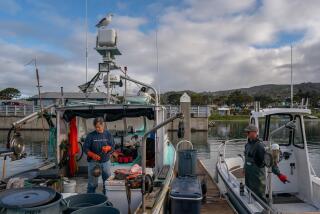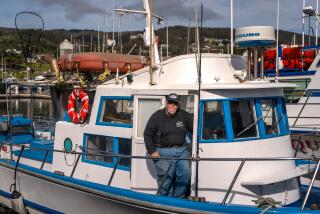The Reel World Cup Tournament Will Begin Today
- Share via
For fishermen throughout most of the United States and Canada, the World Cup kicks off today.
The Chevy Truck World Cup of Fishing, that is. Brain child of David Abbott, the event begins today and lasts through July 30, with $2.1 million in prizes at stake.
“This is something new and different,” says Abbott, a Winnipeg marketing consultant. “The fishing industry hasn’t (become) elevated as such sports as golf and tennis have, in terms of big purses and recognition. I wanted to have a tournament to allow the average guy to hit the big time.”
Participants can fish anywhere in the United States and Canada--except Hawaii--for any of 15 species. Anglers must first buy an entry kit for $10 at Kmart, in which they receive personal identification to use to report their catch.
In the catch-and-release event, each fish must be photographed against an official measuring stick for proof and registered via telephone. Catches are ranked using a conversion scale to account for regional differences in fish size.
Anglers can enter as often as they like. A daily prize of $200 will be awarded for the best catch in every state and Canadian province, and winners could advance to one of five regional playoffs--each worth $100,000 in prize money, with $50,000 going to the winner--that will culminate in a nationally televised final at an as-yet unnamed location for a $1-million grand prize.
Inside each entry kit is a conversion chart and an explanation of rules and regulations.
*
From time to time, Southland wildlife officials have to deal with a wayward bear that wanders into a residential area.
But in at least one portion of Northern California, such incidents are occurring with alarming frequency.
“I’ll bet that over the past two months, we’ve received an average of two calls a day about bear problems,” says Jon Dunn, a Department of Fish and Game warden in Eureka.
Dunn said bears in suburban Eureka are rattling garbage cans, strolling through yards and stealing pet food. One even wandered near a 7-year-old girl waiting at a bus stop.
The DFG isn’t sure how to deal with the problem. The public’s response has been, “Why don’t you trap the bear and take it somewhere else?”
The DFG says such a procedure is neither humane nor practical given the spread of development and the decline of wildlife habitat. Besides, officials say, bears trapped and moved have been known to travel up to 50 miles back to where they were captured. And those that remain in a new area often must compete with other bears for limited food supply.
“Many people who call don’t want us to kill the bear, but they don’t seem to care what its chances for survival would be if it were moved elsewhere,” Dunn says.
For the time being, the DFG’s policy is aimed at eliminating what attracts the bears in the first place, namely the improper treatment of garbage and fruit trees without electric fencing.
Dunn said residents should know what they are getting into when they buy homes in areas that previously supported bears.
“Maybe the time has come in these new developments for real estate disclosure forms to tell potential buyers what they can expect in wildlife experiences,” he says.
Briefly
SALTWATER FISHING--The Southland sportfishing scene has emerged from its early spring doldrums, with barracuda nearly everywhere. Bonito and sand bass have even begun to show in time for the twilight operations that began on Memorial Day weekend. At the southern Channel Islands, yellowtail and white seabass are showing enough to keep the interest of the overnight crowd.
Cabo San Lucas: After four days of gale-force winds that restricted the boats to small-game fishing close to shore, there have been three consecutive days of perfect weather. “Fishing was pretty bad, but on Monday boats were back to catching three to four marlin,” said Juan Arce of the Pisces fleet. Arce said striped marlin are taking mostly live bait off Palmilla and near Chileno, and added that the water has warmed to 71 degrees and that sailfish are making an early showing. Pargo fishing remains excellent for those staying close to shore.
East Cape: Tuna, dorado and marlin are plentiful, with tuna the primary bait-taker in the northern region--some pushing 100 pounds, according to reports out of Hotel Palmas de Cortez--and dorado and marlin are scattered throughout the region.
Loreto: Fishing is excellent for those who like to work the bottom. Pargo, whitefish, cabrilla and triggerfish are plentiful.
San Diego long-range: The Royal Polaris called in Tuesday from Mexico’s Revillagigedo Islands, reporting more than 100 wahoo and, after a slow start, 100- to 200-pound tuna at Roca Partida. The boat returns June 9. The Royal Star, on an eight-day trip to the Alijos Rocks, reported slow to fair fishing for yellowfin tuna and big yellowtail. As others have done before them, they ran into a school of bluefin tuna on the way down.
MISCELLANY--Quail Unlimited’s annual Celebrity Sporting Clays Fun Shoot, including a raffle and an auction, will be held June 11 at 8:30 a.m. at Raahauge’s in Norco. Details: (909) 597-0423. . . . The annual Whitewater Wednesday Rafting Jamboree, featuring $17.50 rides on the Kern River to kick off the rafting season, will be held June 15 beginning at 9 a.m. Details: (619) 376-2629.
More to Read
Sign up for Essential California
The most important California stories and recommendations in your inbox every morning.
You may occasionally receive promotional content from the Los Angeles Times.










